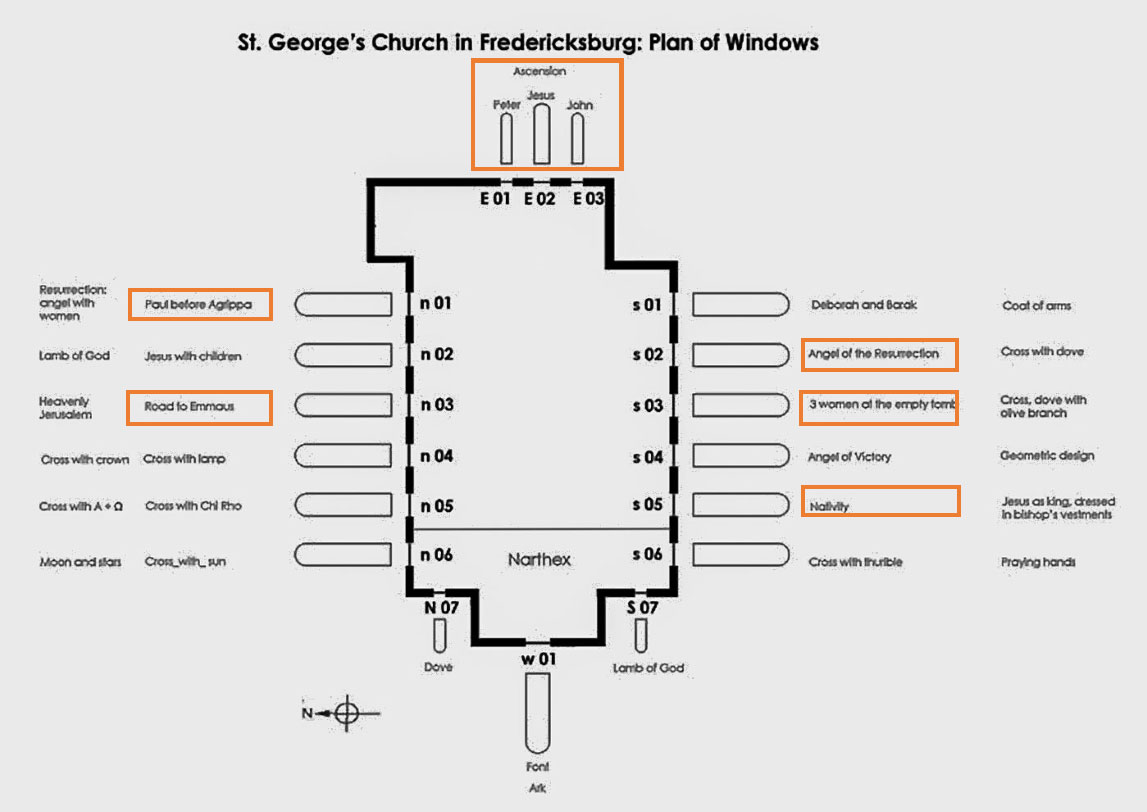
1. Ascension, 1885
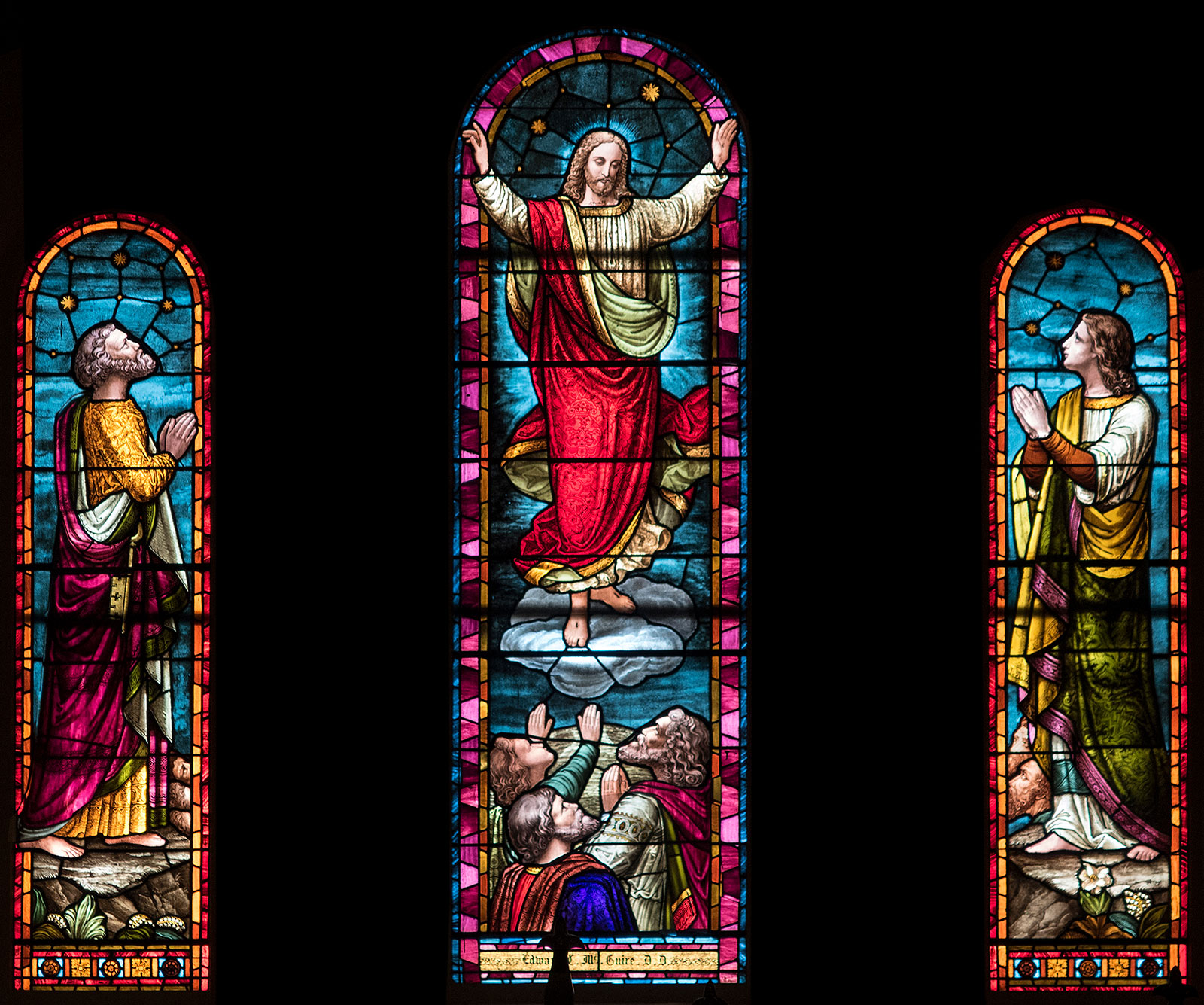
Subject: Ascension
Dedication: In memory of Edward C. McGuire, D.D.
Maker/Date: German, 1885
The Ascension took place 40 days after the Resurrection when Jesus led the disciples to Bethany. He raised his hands, blessed them and then was lifted up until a cloud took him out of their sight. This is shown in the window.
The Acts of the Apostles states that the disciples were in Jerusalem. Jesus appeared before them and commanded them not to depart from Jerusalem, but to wait for the”Promise of the Father”. He stated, “You shall be baptized with the Holy Spirit not many days from now” (Acts 1:5).
After Jesus gave these instructions, He led the disciples to the Mount of Olives. Here, He commissioned them to be His witnesses “in Jerusalem, and in all Judea and Samaria, and to the end of the earth” (Acts 1:8). It is also at this time that the disciples were directed by Christ to “go and make disciples of all nations, baptizing them in the name of the Father and the Son and the Holy Spirit” (Matthew 28:19). Jesus also told them that He would be with them always, “even to the end of the world” (Matthew 28:20).
As the disciples were gazing upwards, two angels appeared with them dressed in white. They said that Jesus would return to them in the same way as they had him leave (Luke 24:50-53, Acts 1:3-11). This is not depicted here in this window. Instead, he is shown, arms raised, disappearing into a cloud with his feet and the hem of his clothes visible. His feet still show scars of the crucifixion.
In the Church of the Ascension on the Mount of Olives, there is an indentation of a rock that is meant to be Jesus’ last footprint on earth. The rock is partially shown on the left window which depicts St. Peter. Jesus asked the disciples, ‘But who do you say that I am?’ and Peter replied ‘You are the Christ, the Son of the living God.’ As a result of that declaration, Jesus said in v 19, ‘I will give you the keys of the kingdom of heaven…’
The right image is probably that of John, the beloved who was always with him. John is always depicted as a young, smooth-faced disciple.
The other 8 disciples are present – three in the bottom right of St. Peter, three in the middle, 2 in the John window. See if you can find them! Judas was not there since he had hanged himself and neither was Thomas.
2 Angel of the Resurrection, 1914
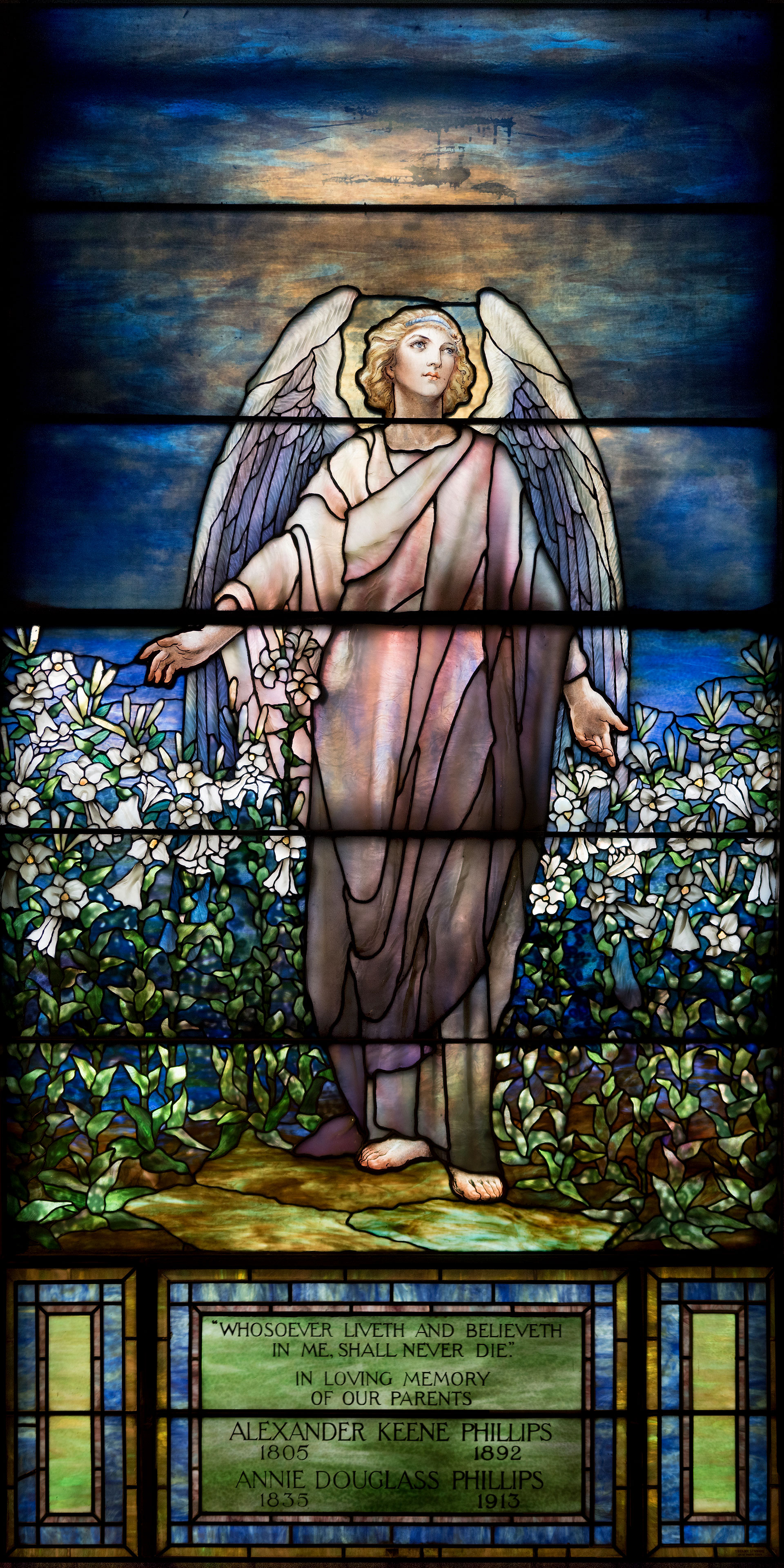
Inscription: “Whosoever Liveth and Believeth In Me, Shall Never Die”
Dedication: In memory of Alexander Keene Phillips, 1805-1892 and Annie Douglas Phillips, 1835-1913, Given by children of Alexander Keene Phillips in memory of parents. The window was dedicated on July 6, 1914.
Maker/Date: Tiffany Studios, New York, 1914
Description – The inscription is from John 11:26. Jesus is speaking with Martha in Bethany, consoling her and is trying to connect the resurrection with the present.
Background – Alexander K. Phillips became the first president of the National Bank of Fredericksburg in 1865 and had been previously involved in many businesses, including grain and mercantile. He owned the Commission House in Fredericksburg which was built for him in 1875 and still stands.
Techniques – The angel announced Jesus’ resurrection in the Gospels. In this window, the angel is sitting in a field of snow-white lilies, clad in robes of pink. The windows show Tiffany’s work in drapery glass for the angel’s robes that are close to fabric folds. Tiffany’s use of glass plays well with the sun which strikes the window in the morning hours. It accentuates the paint and enamel to the face and hands. The yellow-streaked, sun-dappled clouds are a dawn-sky, a common metaphor for rebirth
Another use of glass is fractured glass in the flowers. Fractured glass is embedded glass with tiny paper-thin flakes in different colors. It was made by breaking vessels blown thin, spreading the shards on a marver and embedding them into the molten glass. These multicolored, irregularly shaped fragments produced visually complex effects, which were perfect for representing foliage. Typically this glass was used for landscapes.
A final technique is the use of jewel-like objects in the flowers. These are pieces of hot glass that are press-molded into a jewel-like shape.
3. Three Women at the Tomb, 1908
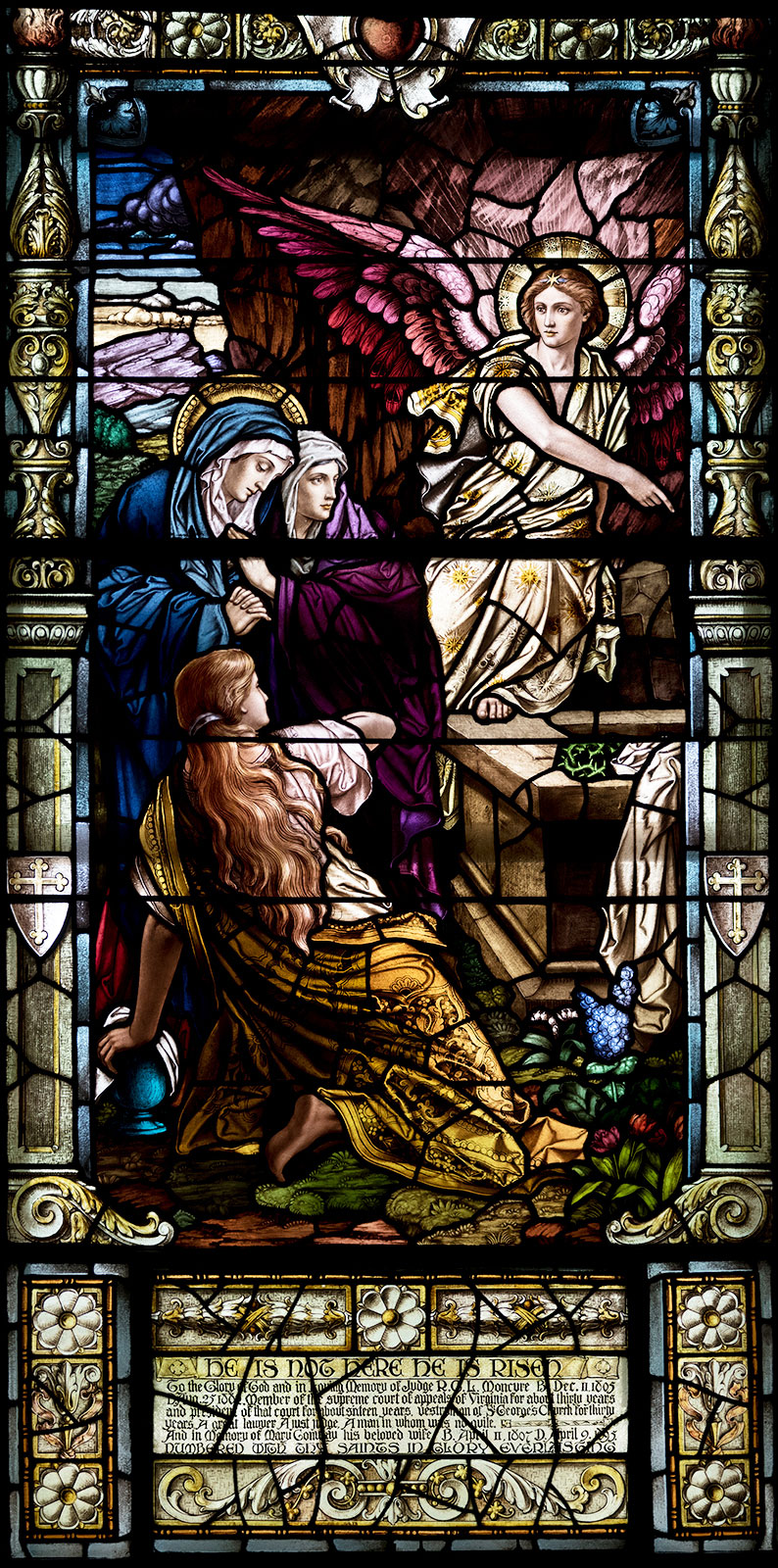
Subject: Three Women at the Tomb
Inscription: “He Is Not Here, He Is Risen”
Dedication: In memory of Judge R. C. L. Moncure, December 11, 1805—August 25, 1882, and Mary Conway Moncure, April 11, 1807—April 9, 1895. A man in whom was no guile
Maker/Date: The maker has not been positively identified though we suspect George Hardy Payne who also did a similar window at the United Methodist Church in Front Royal, Va.
The Payne Studio went through 4 generations before they closed in the 1980s. The date in library publications is 1908. No documentation was found to support that date.
Description – The window depicts the shock of the tomb being open and Jesus not being there. Artistically, the drama of the event is conveyed by the angel pointing to the empty tomb and Mary Magdalene recoiling from the news. The action shifts from top right to bottom left with the two other figures remaining somewhat calm, but comforting each other, providing a contrast to the other characters. The tension is heightened by the closeness of the figures to the observer. The size of the characters reminds us of the importance of the event at hand and reinforces the drama.
A messenger is included in all Gospel accounts has been translated to “angel”. The angel in the window is female which varies from all Gospel accounts but fits the more popular concept of angels. Mark clearly says it is a “young man in a white robe seated on the right side” Luke differs from the other Gospels by including two angels. Angels have many meanings in the Bible – this angel is clearly the messenger type.
It is early in the morning. At the top of the window, light comes over Golgotha – note the three crosses for the crucifixions earlier in the week. John speaks of “very early, and still dark” (John 20:1) where Mark says it is “very early in the morning… when the sun had risen” (Mark 16:2). The tomb is not a traditional Jewish tomb but a modern box tomb and the cover has been removed. (However, the rock background may be shown behind the angel). There is no stone that has been rolled away and no guard as described by Mathew. The angel is not in the tomb where the body of Christ had been as recorded in all accounts.
So why were the women there observing Jesus’ body? Mark suggests that they wanted to attend to the body in their own special way after the Passover Sabbath.
Mary Magdalene is holding on to a blue vase. Inside the blue vase would have been perfumes and ointments to perform their own rites on Jesus’ body in preparation of burial, traditionally performed by Jewish women. She is dressed in vivid garments with red hair. This refers to her checkered past as one possessed by demons but as one who loved Jesus. Her hair is exposed and relatively loosened which would be a sign that she is not chaste.
Mary the mother has a halo and is praying fitting Luke’s account of a praying woman. Salome is transfixed, staring at the vacant tomb, in shock while at the same time comforting Mary the mother. They function as important witnesses of the event.
On the right side of the window, there are two symbols of Jesus’ resurrection – the white burial garment and the crown of thorns. The latter specifically identifies Jesus. If Jesus had been stolen, his body would have remained wrapped – the garment would not have been left behind. It is clear that Jesus has been transformed. Three of the Gospels, Mathew, Mark, and Luke speak of a larger cloth that would have covered the body. John uses “linen cloths” which some have interpreted as a face cloth but does not include the larger cloth.
The flowers (lilies of the Valley, Hyacinths, tulips) are spring flowers and may symbolize the new life stemming from the resurrection for Christ’s followers. The lilies open toward the heavens as Christ has risen from the tomb. New life is also apparent on the shining suns on the angel’s garments and also is a symbol for Christ.
4. Nativity (1943)
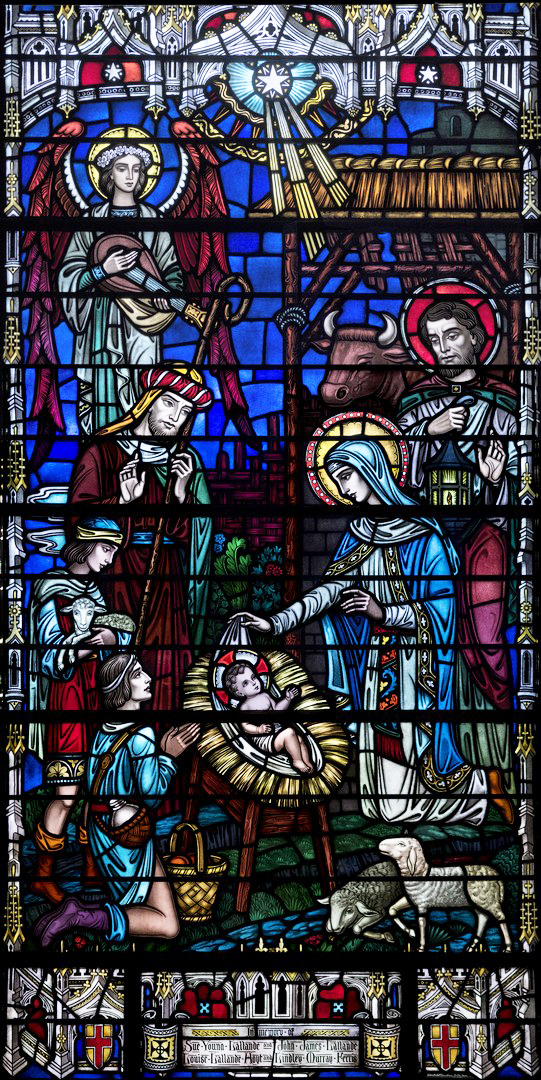
Lower Subject: Nativity
Inscription: None
Dedication: In memory of Sue Young Lallande and John James Lallande, Louise Lallande Hoyt and Lindley Murray Ferris
Maker/Date: Wilbur Herbert Burnham, Boston, Massachusetts, 1943
Background – This was the last window added to St. George’s and was donation outside the Parish.
Wilbur Herbert Burnham, born in Boston in 1887, was an artist and master craftsman in stained glass. Burnham was commissioned to design windows for churches and cathedrals in the United States and in Europe. Among his most notable works are windows in the Cathedral of Sts. Peter and Paul, Washington DC, the Cathedral of St. John the Divine and Riverside Church in New York City, Princeton University Chapel, and the American Church in Paris. Burnham was a member of the Neo-Gothic school.
They imitated the color palette of Chartres Cathedral in France, principally red and blue, with touches of secondary colors. They also imitated the forms, medallion windows for the aisles and large figures for the clerestories. They imitated medieval figure drawing, once called “stained-glass attitudes.” Since the ideal in the church was a “dim religious light” they imitated the patina of the ages with thin washes of glass paint and picked out highlights.
All the color was in the glass and moved away from Tiffany’s use of painting. Colored glass, known as “metal” was made by adding various metallic oxides to the crucibles in which the glass was melted. Cobalt gave blue, copper green, iron red, gold cranberry, silver yellows and gold, copper makes greens and brick red.
Description: The star and the Baby Jesus neatly divide the scene with a touch of the rose for new life just above Jesus. Mary and Joseph on the right are clearly separated from the visitors on the left. It is very iconic, inclusive and balanced – the two shepherds, one King, and the angel strumming a lute on the left against the other characters. The colors are both vivid and varied. The blue sky provides a backup against the red wings of the angel, the cow, and the different color of the halos. The clothes are multi-colored – red, blues and different shades of green. The figures are European and could have been taken from Renaissance or earlier European paintings.
This is a bright window, especially in the full sunlight that reinforces the event. The use of small pieces of multicolored glass creates the effect. This contrasts with the Church’s Tiffany window where the figures could be indistinguished from a painting. The characters are definitely those of windows without the preciseness of the Tiffany approach with the use of staining different pieces of glass.
Burnham’s must have thought of the interplay of the sun coming through the window. The morning sun shining through the window comes right through the star projecting star rays on the upper gallery.
5. Road to Emmaus (1912)

Subject: The Road to Emmaus
Inscription: none
Dedication: In memory of Rawleigh W. Downman, 1860-1881 and James H. Downman, 1862-1911, sons of William Yates and Mary Ann Downman. This was the first Tiffany installed at St. George’s in 1912.
Tiffany Studios produced three windows for Saint George’s Episcopal Church between 1912 and 1917. Each was intended as a memorial to specific members of the congregation, the earliest being the double window installed in 1912 on the left side of the nave.
Donor: Mary Ann Downman was 90 years old in 1923, living in the same home that she was married and was the oldest person in Fredericksburg at the time.
She had six children, three that predeceased her. One child Rev John Yates Downman (1858-1949) became rector at St. Paul’s Episcopal in Richmond. The window was dedicated to two of her sons who had predeceased her. Rawleigh Downman died at age 21 visiting an uncle at Baltimore when he died. James Downman was a successful New York businessman who had suffered a stroke and returned to his sister Nannie’s home. There he was the victim of a hunting accident.
Maker/Date: Tiffany Studios, New York, 1912
Description: This window is located over the north side of the Church and receives the afternoon sun.
The story of this window is from Luke, chapter 24, verses 13 to 35. Two disciples encounter Jesus shortly after his resurrection. The look of incredulity and awe on the faces of the men stands in contrast to the dignity and still expression of Christ.
In the image, Cleopas and an unnamed companion encounter the risen Christ on the road to Emmaus about seven miles from Jerusalem. The men are shocked that anyone could have been in Jerusalem and not known about the events that have happened there. “Abide with us,” they ask the unrecognized stranger, “for it is toward evening, and the day is far spent.” It was not until they offered Him hospitality and He blessed and broke the bread that they recognized Him. He soon disappeared. They got up and returned at once to Jerusalem. There they found the Eleven and those with them, assembled together and saying, “It is true! The Lord has risen and has appeared to Simon.”
Techniques: Christ faces toward us, but the men are turned inward, a compositional device that gives the illusion of depth. As in most figural windows by Tiffany Studios, the faces and arms are painted with enamel. Drapery glass creates ripples of undulating fabric, as well as areas of shading, realistically depicting the figures’ forms. Plated spotted and confetti glass are used to portray the dappled leaves on the trees in the background. To make confetti glass, small, irregularly shaped pieces of glass are embedded to the reverse of a sheet of glass.
In the Biblical passage, the two disciples do not recognize Christ when they meet him. To convey this mystical aspect of Christ, the artist took into account the window’s placement in the church in relation to the composition of the window. Without illumination from the sun, the features of Christ’s face are unrecognizable. But in daylight, Christ’s identity is apparent to the men and the viewer alike.
The faces of the two companions show apprehension as they study the unknown man. The dark brown and green clothing contrasts with the lighter shades used in Christ’s robe.
6. St. Paul Before Agrippa
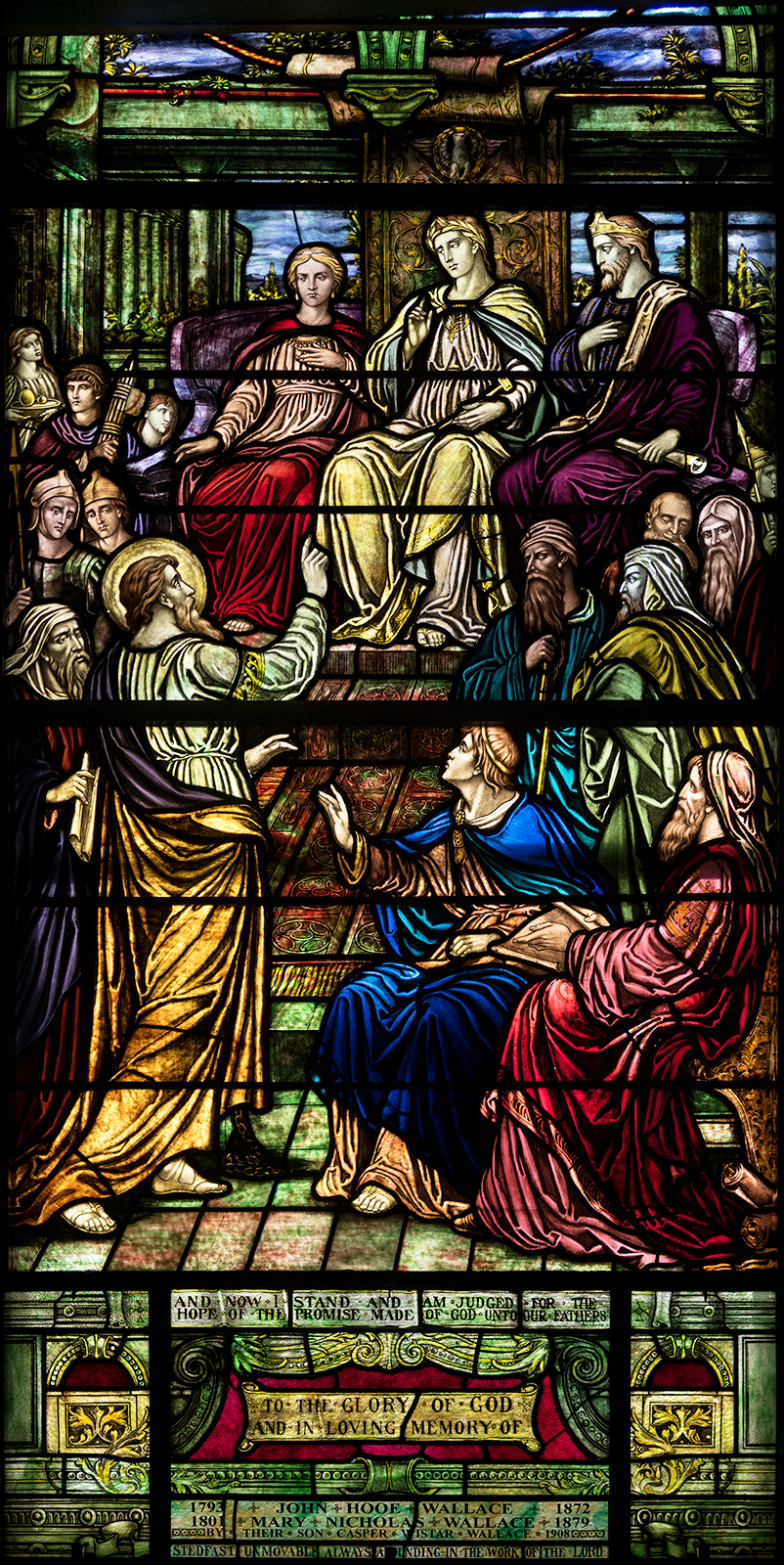 <
<
Lower Subject: Saint Paul Before Agrippa
Description: Window was reported to be in position by the Daily Star in an article on March 28, 1908
Donor: Wistar Wallace was responsible for this window through his will and for investment in what would become the Wallace Library just across George Street.
Techniques: Paul is rendered larger than the other figures which may indicate both the subject of the window and the fact he had the upper hand. He is the only figure with a halo. The Jewish leaders appear on the right, visibly angry and the Romans on the left with the Roman columns in the background and the Roman Fasces (bundles), a symbol for authority also on the left. The prosecutor Festus appears uneasy on the way the proceedings have been going and Bernice and Agrippa on either side appear to be scowling.
Religious Background – Paul was imprisoned in Caesarea and had been proved innocent four different trials or hearings: before the mob, before the Sanhedrin, before Felix, and before Festus but he was still being imprisoned in Caesarea. Paul has not done what he was accused – 1. blaspheming God by desecrating the temple 2. Encouraging people to disobey Mosaic Law 3. Sedition, working as an insurrectionist and creating riots against the government. Both the Jewish and Roman courts attested that he had not done those things.
Who were these people?
- Agrippa was one of the Herods. He was the son of Herod Agrippa 1 who had James beheaded and Peter imprisoned. Herod Agrippa II’s great uncle, Herod Antipas, beheaded John the Baptist. However, Agrippa was a small-time king, small area of Northern Palestine and Galilee. Bernice was Agrippa’s sister
- Festus was the prosecutor of Judea
- Felix was the governor
- Bernice was also the sister of Drusilla, the wife of Felix
So why was Paul retained as a prisoner?
Paul was retained as a prisoner because the Roman governors didn’t have the courage to release him. They knew the Jewish leaders wanted him dead and they were afraid to let Paul go. They wanted him to be condemned and executed. On the basis of Roman justice, Festus couldn’t honor the demand of the Jewish leaders. He didn’t have any accusations
At the beginning of Acts 25, Festus had gone to Jerusalem to meet with the Jewish leaders where they wanted him transferred to Jerusalem. They secretly plotted to kill him Festus instead said he was going to Caeseria and encourage some of them to accompany him there and present the charges.
In the hearing Paul appealed for a decision from the Emperor which a Roman could do and thus go to Rome Once Paul made the appeal, Festus had no choice–he commanded Paul to be retained in Caesarea until he could send him to Rome. But he couldn’t send him because he didn’t know what to tell Rome about him. He couldn’t tell them that Paul was mad, claiming that someone was alive who was really dead. Rome wouldn’t have been interested
A few days later Agrippa and Bernice arrived in Caesarea for a courtesy call for Festus. This was a great opportunity for Festus Festus admitted that the Jewish leaders didn’t have a case and the only issue was “some points of dispute with him about their own religion” and about the resurrection when claimed Christ was still alive He couldn’t send Paul to Rome without an accusation, so he turned his problem over to Agrippa. They had to find an accusation
The stained glass window depicts the hearing.
Besides the above and chief captains, and principal men of the city as well as Jewish leaders Paul was not very imposing physically. With all the glitter in the auditorium, in walks a little bandy-legged, baldheaded, Jewish man He was shackled by a chain as he stood in the middle of the auditorium. Festus is in the middle with King Agrippa and Bernice on either side
As the Daily Star writes about the window “The subject of the picture is the argument of Paul on the resurrection of the dead, Acts Chapters 25 and 26. The picture itself represents Paul in chains before Festus, with King Agrippa and Bernice on either side. Paul’s accusers, guards, chief priests, and people around, with the quotation beneath his speech “And now I stand and am judged for the hope of the promise made of God unto our fathers.”
Since this was more of a hearing, Paul didn’t have to be there. He was there was another platform for him to preach Christ. He turned everything that ever happened to him into an opportunity to preach Christ. He had been waiting two years to say something, and now he had his opportunity
Paul reviews his conversion on the road to Damascus. “I preached that they should repent and turn to God and prove their repentance by their deeds.” am saying nothing beyond what the prophets and Moses said would happen—that the Christ would suffer and, as the first to rise from the dead, would proclaim light to his own people and to the Gentiles.”
Festus responded that he thought Paul was out of his mind. He couldn’t understand why the Jewish leaders would bother with him. But Festus didn’t understand the implications of the resurrection because he didn’t understand the implications of the Messiah.
When Paul ended his testimony in Acts 26:28, Agrippa said, “Are you trying to convert me?” That’s exactly what Paul was trying to do, and not only Agrippa but everyone else as well.
Paul replied, “Short time or long—I pray God that not only you but all who are listening to me today may become what I am, except for these chains.”
The king rose and with him the governor and Bernice and those sitting with them. They left the room, and while talking with one another, they said, “This man is not doing anything that deserves death or imprisonment.” Agrippa said to Festus, “This man could have been set free if he had not appealed to Caesar.